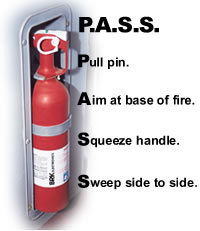| Admissions | Accreditation | Booksellers | Catalog | Colleges | Contact Us | Continents/States/Districts | Contracts | Distance Education | Emergency | Examinations | Forms | Grants | Hostels | Honorary Doctorate degree | Investment | Instructors | Lecture | Librarians | Membership | Professional Examinations | Programs | Recommendations | Research Grants | Researchers | Students login | School | Search | Seminar | Study Center/Centre | Sponsorship | Tutoring | Thesis | Universities | Work counseling |
To remember how to properly use a fire extinguisher-remember P.A.S.S.

P: Pull pin. A: Aim at base of fire. S: Squeeze handle. S: Sweep side to side. P.A.S.S. for using fire extinguishers Here are the most common types of fire extinguishers: * Water extinguishers or APW extinguishers (air-pressurized water) are suitable for class A fires only. Never use a water extinguisher on grease fires, electrical fires or class D fires - the flames will spread and make the fire bigger! Water extinguishers are filled with water and are typically pressurized with air. Again - water extinguishers can be very dangerous in the wrong type of situation. Only fight the fire if you're certain it contains ordinary combustible materials only. * Dry chemical extinguishers come in a variety of types and are suitable for a combination of class A, B and C fires. These are filled with foam or powder and pressurized with nitrogen. o BC - This is the regular type of dry chemical extinguisher. It is filled with sodium bicarbonate or potassium bicarbonate. The BC variety leaves a mildly corrosive residue which must be cleaned immediately to prevent any damage to materials. o ABC - This is the multipurpose dry chemical extinguisher. The ABC type is filled with monoammonium phosphate, a yellow powder that leaves a sticky residue that may be damaging to electrical appliances such as a computer Dry chemical extinguishers have an advantage over CO2 extinguishers since they leave a non-flammable substance on the extinguished material, reducing the likelihood of re-ignition. * Carbon Dioxide (CO2) extinguishers are used for class B and C fires. CO2 extinguishers contain carbon dioxide, a non-flammable gas, and are highly pressurized. The pressure is so great that it is not uncommon for bits of dry ice to shoot out the nozzle. They don't work very well on class A fires because they may not be able to displace enough oxygen to put the fire out, causing it to re-ignite. CO2 extinguishers have an advantage over dry chemical extinguishers since they don't leave a harmful residue - a good choice for an electrical fire on a computer or other favorite electronic device such as a stereo or TV. It is vital to know what type of extinguisher you are using. Using the wrong type of extinguisher for the wrong type of fire can be life-threatening. These are only the common types of fire extinguishers. There are many others to choose from. Base your selection on the classification and the extinguisher's compatibility with the items you wish to protect. Most fire extinguishers contain a fairly small amount of fire-suppressant material -- you can use it all up in a matter of seconds. For this reason, extinguishers are only effective on relatively small, contained fires. To put out a larger fire, you need much bigger equipment -- a fire engine, for example -- and the professionals who know how to use it. But for the dangerous flames that can pop up in your house, a fire extinguisher is an invaluable lifesaver. |
